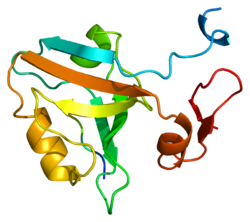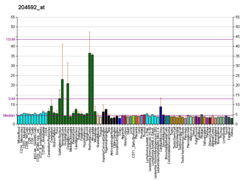DLG4
Mammalian protein found in Homo sapiens From Wikipedia, the free encyclopedia
PSD-95 (postsynaptic density protein 95) also known as SAP-90 (synapse-associated protein 90) is a protein that in humans is encoded by the DLG4 (discs large homolog 4) gene.[5][6][7]
PSD-95 is a member of the membrane-associated guanylate kinase (MAGUK) family. With PSD-93 it is recruited into the same NMDA receptor and potassium channel clusters. These two MAGUK proteins may interact at postsynaptic sites to form a multimeric scaffold for the clustering of receptors, ion channels, and associated signaling proteins.[5] PSD-95 is the best studied member of the MAGUK-family of PDZ domain-containing proteins. Like all MAGUK-family proteins, its basic structure includes three PDZ domains, an SH3 domain, and a guanylate kinase-like domain (GK) connected by disordered linker regions. It is almost exclusively located in the post synaptic density of neurons,[8] and is involved in anchoring synaptic proteins. Its direct and indirect binding partners include neuroligin, NMDA receptors, AMPA receptors, and potassium channels.[9] It plays an important role in synaptic plasticity and the stabilization of synaptic changes during long-term potentiation.[10]
MAGUK superfamily and constituent domains
Summarize
Perspective
PSD-95 (encoded by DLG4) is a member of the MAGUK superfamily, and part of a subfamily which also includes PSD-93, SAP97 and SAP102. The MAGUKs are defined by their inclusion of PDZ, SH3 and GUK domains, although many of them also contain regions homologous of CaMKII, WW and L27 domains.[11] The GUK domain that they have is structurally very similar to that of the guanylate kinases, however it is known to be catalytically inactive as the P-Loop which binds ATP is absent. It is thought that the MAGUKs have subfunctionalized the GUK domain for their own purposes, primarily based on its ability to form protein-protein interactions with cytoskeleton proteins, microtubule/actin based machinery and molecules involved in signal transduction.
The PDZ domain which are contained in the MAGUKs in varying numbers, is replicated three times over in PSD-95. PDZ domains are short peptide binding sequences commonly found at the C-terminus of interacting proteins. The three copies within the gene have different binding partners, due to amino acid substitutions within the PSD-95 protein and its ligands. The SH3 domain is again a protein-protein interaction domain. Its family generally bind to PXXP sites, but in MAGUKs it is known to bind to other sites as well. One of the most well known features is that it can form an intramolecular bond with the GUK domain, creating what is known as a GUK-SH3 'closed' state. The regulatory mechanisms and function are unknown but it is hypothesized that it may involve a hook region and a calmodulin binding region located elsewhere in the gene.
Interactions
PSD-95 has been shown to interact with:
- ADAM22[12]
- Beta-1 adrenergic receptor[13]
- CACNG2[14][15]
- CASK[16]
- DLG3[17]
- DLGAP1[18][19][20][21][22][23]
- DLGAP2[19]
- DYNLL1[18]
- DYNLL2[18]
- ERBB4[24][25]
- EXOC4[26][27]
- FYN[28][29]
- FZD7[30]
- GRIK1[31]
- GRIK2[32][33]
- GRIK5[32][33]
- GRIN2A[21][28][34][35]
- GRIN2B[26][34][36][37][38][39]
- GRIN2C[36]
- HER2/neu[24]
- HGS[16]
- KCNA2[40]
- KCNA4[37][38][40][41]
- KCNA5[40][42]
- KCNJ12[37][43][44][45]
- Kir2.1[45]
- LGI1[12]
- LRP1[46]
- LRP2[46][47]
- NLGN1[34]
- NOS1[48][49]
- PTK2B[50]
- SEMA4C[51] and
- SHANK2.[18][20]
See also
References
External links
Wikiwand - on
Seamless Wikipedia browsing. On steroids.







